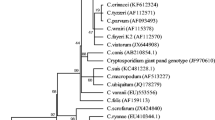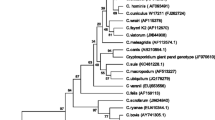Abstract
The occurrence of Cryptosporidium and Giardia species in slaughter, sewage and river waters of the Qinghai Tibetan Plateau Area (QTPA), China, was investigated. A total of 456 samples were collected from different locations in the QTPA to study the contamination rates of Cryptosporidium spp. and Giardia via PCR and subsequent sequence analysis. Ten samples were Cryptosporidium positive, and 97 were Giardia positive, as confirmed by PCR amplification of the SSU rRNA gene. The percentages of positive Cryptosporidium and Giardia detection were 2.2% (10/456) and 21.3% (97/456), respectively. Cryptosporidium was detected in only sewage and river waters. Six species of Cryptosporidium were identified: Cryptosporidium hominis (n = 5), C. andersoni (n = 1), C. environmental (n = 1), C. struthionis (n = 1), C. canis (n = 1), and C. parvum (n = 1). G. duodenalis assemblage A was identified in almost all positive samples (n = 96), and one sample harboured G. duodenalis assemblage E. The results suggest that Cryptosporidium and Giardia species circulate through the aqueous environment and different hosts. Therefore, we strongly recommend that the local government and health authorities in China undertake control measures to reduce the contamination of water sources by these protozoa to protect the health of humans and animals.



Similar content being viewed by others
Change history
14 November 2019
The authors of this article would like to state that <Emphasis Type="Italic">C.</Emphasis> environmental is not a species, but rather a group of un-identified <Emphasis Type="Italic">Cryptosporidium</Emphasis> isolates from the environment. It is referred to in the literature as <Emphasis Type="Italic">Cryptosporidium</Emphasis> environmental sequence and not as a species.
References
Ahmed SA, Karanis P (2018a) An overview of methods/techniques for the detection of Cryptosporidium in food samples. Parasitol Res 117:629–653
Ahmed SA, Karanis P (2018b) Comparison of current methods used to detect Cryptosporidium oocysts in stools. Int J Hyg Environ Health S1438-4639(17):30469–30468
Appelbee AJ, Frederick LM, Heitman TL, Olson ME (2003) Prevalence and genotyping of Giardia duodenalis from beef calves in Alberta, Canada. Vet Parasitol 112:289–294
Baldursson S, Karanis P (2011) Waterborne transmission of protozoan parasites: a review of worldwide outbreaks - an update 2004-2010. Water Res 45:6603–6614
Cacciò SM, Chalmers RM (2016) Human cryptosporidiosis in Europe. Clin Microbiol Infect 22:471–480
Efstratiou A, Ongerth J, Karanis P (2017) Evolution of monitoring for Giardia and Cryptosporidium in water. Water Res 123:96–112
Erickson MC, Ortega YR (2006) Inactivation of protozoan parasites in food, water, and environmental systems. J Food Prot 69:2786–2808
Farizawati S, Lim YA, Ahmad RA, Fatimah CT, Siti-Nor Y (2005) Contribution of cattle farms towards river contamination with Giardia cysts and Cryptosporidium oocysts in Sungai Langat Basin. Trop Biomed 22:89–98
Feng Y, Zhao X, Chen J, Jin W, Zhou X, Li N, Wang L, Xiao L (2011) Occurrence, source, and human infection potential of Cryptosporidium and Giardia spp. in source and tap water in Shanghai, China. Appl Environ Microbiol 77:3609–3616
Garcia RJC, Hayman DT (2016) Origin of major infectious disease in vertebrates: the timing of Cryptosporidium evolution and its hosts. Parasitol 143:1683–1690
Hu Y, Feng Y, Huang C, Xiao L (2014) Occurrence, source, and human infection potential of Cryptosporidium and Enterocytozoon bieneusi in drinking source water in Shanghai, China, during a pig carcass disposal incident. Environ Sci Technol 48:14219–14227
Huang C, Hu Y, Wang L, Wang Y, Li N, Guo Y, Feng Y, Xiao L (2017) Environmental transport of emerging human-pathogenic Cryptosporidium species and subtypes through combined sewer overflow and wastewater. Appl Environ Microbiol 83(16):pii: e00682–pii: e00617
Jian Y, Zhang X, Li X, Karanis G, Ma L, Karanis P (2018) Prevalence and molecular characterization of Giardia duodenalis in cattle and sheep from the Qinghai-Tibetan plateau area (QTPA), northwestern China. Vet Parasitol 250:40–44
Karanis P, Kourenti C, Smith H (2007a) Waterborne transmission of protozoan parasites: a worldwide review of outbreaks and lessons learnt. J Water Health 5:1–38
Karanis P, Plutzer J, Halim NA, Igori K, Nagasawa H, Ongerth J, Liqing M (2007b) Molecular characterization of Cryptosporidium from animal sources in Qinghai province of China. Parasitol Res 101:1575–1580
Karanis P, Schoenen D, Seitz HM (1996) Giardia and Cryptosporidium in backwash water from rapid sand filters used for drinking water production. Zentralbl Bakteriol 284:107–101
Karanis P, Schoenen D, Seitz HM (1998) Distribution and removal of Giardia and Cryptosporidium in water supplies in Germany. Water Sci Technol 37:9–18
Koehler AV, Haydon SR, Jex AR, Gasser RB (2016) Cryptosporidium and Giardia taxa in fecal samples from animals in catchments supplying the city of Melbourne with drinking water (2011 to 2015). Parasit Vectors 9:315
Li K, Shahzad M, Zhang H, Jiang X, Mehmood K, Zhao X, Li J (2018) Socio-economic burden of parasitic infections in yaks from 1984 to 2017 on Qinghai Tibetan Plateau of China-A review. Acta Trop 183:103–109
Li N, Xiao L, Wang L, Zhao S, Zhao X, Duan L, Guo M, Liu L, Feng Y (2012) Molecular surveillance of Cryptosporidium spp., Giardia duodenalis, and Enterocytozoon bieneusi by genotyping and subtyping parasites in wastewater. PLoS Negl Trop Dis 6:e1809
Li P, Cai J, Cai M, Wu W, Li C, Lei M, Xu H, Feng L, Ma J, Feng Y, Xiao L (2016) Distribution of Cryptosporidium species in Tibetan sheep and yaks in Qinghai, China. Vet Parasitol 215:58–62
Liu A, Ji H, Wang E, Liu J, Xiao L, Shen Y, Li Y, Zhang W, Ling H (2011) Molecular identification and distribution of Cryptosporidium and Giardia duodenalis in raw urban wastewater in Harbin, China. Parasitol Res 109:913–918
Ma L, Sotiriadou I, Cai Q, Karanis G, Wang G, Wang G, Lu Y, Li X, Karanis P (2014) Detection of Cryptosporidium and Giardia in agricultural and water environments in the Qinghai area of China by IFT and PCR. Parasitol Res 113:3177–3184
Ma J, Feng Y, Hu Y, Villegas EN, Xiao L (2016) Human infective potential of Cryptosporidium spp., Giardia duodenalis and Enterocytozoon bieneusi in urban wastewater treatment plant effluents. J Water Health 14:411–423
Mahmoudi MR, Ongerth JE, Karanis P (2017) Cryptosporidium and cryptosporidiosis: the Asian perspective. Int J Hyg Environ Health 220:1098–1109
Mi R, Wang X, Li C, Huang Y, Zhou P, Li Z, Lei M, Cai J, Chen Z (2013) Prevalence and genetic characterization of Cryptosporidium in yaks in Qinghai province of China. PLoS One 8:e74985
Nichols RA, Campbell BM, Smith HV (2003) Identification of Cryptosporidium spp. oocysts in United Kingdom non-carbonated natural mineral waters and drinking waters by using a modified nested PCR-restriction fragment length polymorphism assay. Appl Environ Microbiol 69:4183–4189
Plutzer J, Karanis P (2009) Genetic polymorphism in Cryptosporidium species: an update. Vet Parasitol 165:187–199
Plutzer J, Ongerth J, Karanis P (2010) Giardia taxonomy, phylogeny, and epidemiology: facts and open questions. Int J Hyg Environ Health 213:321–333
Rosado-García FM, Guerrero-Flórez M, Karanis G, Hinojosa MDC, Karanis P (2017) Water-borne protozoa parasites: the Latin American perspective. Int J Hyg Environ Health 220:783–798
Ryan U, Hijjawi N, Xiao L (2018) Foodborne cryptosporidiosis. Int J Parasitol 48:1–12
Upton SJ, Current WL (1985) The species of Cryptosporidium (Apicomplexa: Cryptosporidiidae) infecting mammals. J Parasitol 71:625–629
Xiao S, An W, Chen Z, Zhang D, Yu J, Yang M (2012) Occurrences and genotypes of Cryptosporidium oocysts in river network of southern-eastern China. Parasitol Res 110:1701–1709
Xiao G, Qiu Z, Qi J, Chen JA, Liu F, Liu W, Luo J, Shu W (2013) Occurrence and potential health risk of Cryptosporidium and Giardia in the Three Gorges Reservoir, China. Water Res 47:2431–2445
Xiao S, Yin P, Zhang Y, Hu S (2017) Occurrence of Cryptosporidium and Giardia and the relationship between protozoa and water quality indicators in swimming pools. Korean J Parasitol 55:129–135
Xiao S, Yin P, Zhang Y, Zhao X, Sun L, Yuan H, Lu J, Hu S (2018) Occurrence, genotyping, and health risk of Cryptosporidium and Giardia in recreational lakes in Tianjin, China. Water Res 141:46–56
Zhang X, Jian Y, Li X, Ma L, Karanis G, Karanis P (2018a) The first report of Cryptosporidium spp. in Microtus fuscus (Qinghai vole) and Ochotona curzoniae (wild plateau pika) in the Qinghai-Tibetan plateau area, China. Parasitol Res 117:1401–1407
Zhang X, Jian Y, Li X, Ma L, Karanis G, Qigang C, Karanis P (2018b) Molecular detection and prevalence of Cryptosporidium spp. infections in two types of domestic farm animals in the Qinghai-Tibetan plateau area (QTPA) in China. Parasitol Res 117:233–239
Acknowledgments
We acknowledge the funding support from the One Thousand Talents Plan of the Chinese Government (NO. WQ2013630172).
Author information
Authors and Affiliations
Corresponding author
Additional information
Handling Editor: Julia Walochnik
Publisher’s note
Springer Nature remains neutral with regard to jurisdictional claims in published maps and institutional affiliations.
Rights and permissions
About this article
Cite this article
Ma, L., Zhang, X., Jian, Y. et al. Detection of Cryptosporidium and Giardia in the slaughterhouse, sewage and river waters of the Qinghai Tibetan plateau area (QTPA), China. Parasitol Res 118, 2041–2051 (2019). https://doi.org/10.1007/s00436-019-06330-w
Received:
Accepted:
Published:
Issue Date:
DOI: https://doi.org/10.1007/s00436-019-06330-w




